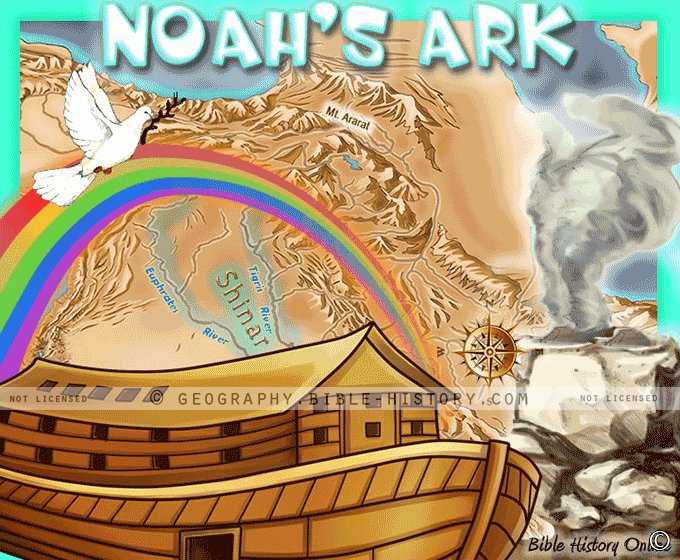
Noah's Ark stands as one of the most iconic and enduring stories in human history, transcending time, culture, and faith. Rooted in the Book of Genesis, this narrative recounts the tale of a righteous man, a colossal vessel, and a world-transforming flood. Beyond its captivating imagery, Noah's Ark carries profound themes of renewal, faith, and the enduring connection between humanity and the divine.
The Call to Build
According to the biblical account, Noah was chosen by God to build an ark, a colossal vessel designed to preserve life during a cataclysmic flood. Guided by divine instructions, Noah embarked on a monumental task that would require unwavering faith, meticulous craftsmanship, and steadfast determination.
The Gathering of Creatures
Noah's Ark is renowned for its role as a sanctuary for pairs of animals representing Earth's diverse species. As the floodwaters rose, the ark became a vessel of salvation, symbolizing God's care for creation and his desire to ensure the survival of all life forms. This gathering of animals symbolizes the interconnectedness of life and the promise of renewal.
The Flood and Divine Covenant
As the floodwaters engulfed the earth, Noah and his family found refuge within the ark. This period of isolation marked a cleansing and renewal of the world. After the waters receded, God established a covenant with Noah, signified by a rainbow—a promise that the earth would never again be destroyed by a global flood. This covenant represents a bond between humanity and the divine, a reminder of God's mercy and the potential for renewal.
Lessons of Faith and Obedience
Noah's Ark encapsulates lessons of faith, obedience, and trust in the face of adversity. Noah's unwavering commitment to building the ark, even in the absence of immediate signs of catastrophe, serves as a model of devotion and submission to the divine will. His willingness to heed God's call is a testament to the power of faith to guide individuals through trials and challenges.
Universal Significance
The story of Noah's Ark extends beyond religious boundaries, resonating with various cultures and traditions. It is a narrative that underscores the human experience of adversity and renewal, offering hope and reassurance in times of uncertainty. The ark itself has become a symbol of refuge, transformation, and the potential for new beginnings.
Noah's Ark is more than a story; it's a timeless metaphor that spans generations, cultures, and beliefs. It encapsulates themes of faith, renewal, and divine covenant that continue to inspire individuals to navigate the challenges of life with hope and perseverance. As we reflect on the journey of Noah and the ark, we uncover profound insights into the nature of humanity's relationship with the divine and the enduring power of stories that illuminate our shared journey.
Blank Topo Map of The World
Abraham’s Journey
The Captivity of Judah (586-516 B.C.)
The Fall of Judah 586 B.C.
The Northern Kingdom of Israel
The Southern Kingdom of Judah
The Divided Kingdom
The Fertile Crescent
Ur of the Chaldees
Shechem in Old Testament Times
Prophets, Kings, and Nations
Jesus Last Passover
New Testament Israel
New Testament Places
Old Testament Israel
Provinces of the Roman Empire
Israel during David’s Kingdom
David’s Kingdom
Cities of the New Testament 4
Cities of the New Testament 3
Cities of the New Testament 2
Mediterranean Sea
Cities of the New Testament
First Century Jerusalem
Empire of David and Solomon
David’s Kingdom
Israel Under Rehoboam
Ophir and Tarshish
The Period of the Kings
Ramoth Gilead
Samaria
Solomon’s Temple
Zarephath and MT Carmel
Jabesh Gilead and Tribes
Judah in the Time of David
Kingdom of Saul
Kirjath Jearim
Michmash
Mount Gilboa in the Time of David
Nob Davids Flight
Shiloh
Israel and Judah
Assyrian Empire Under Esarhaddon
Assyrian Empire Under Sennacherib
Captivity of 10 Tribes
Events in 2 Kings
The Khabur River
Israel and Syria
Captives From Judah
Kingdom of Jeroboam
Mesha’s Kingdom
Pharaoh Necho Battles King Josiah at Megiddo
Babylonian, Mede and Persian Empires
Samaria and Nearby Territories
Syria at its Height
Hebron
Mahanaim
1949 Map of Israel With Boundaries
First & Second Journeys of Paul
Journeys of the Apostles
Paul’s Third Missionary Journey
Saul’s Journey to Damascus and Arabia
Paul’s Final Visits
Paul’s 1st Missionary Journey
Paul’s 2nd Missionary Journey
Paul’s 3rd Missionary Journey
Paul’s Voyage to Rome
Phillip Journeys to Samaria and Gaza
Judah at the Time of Amos
Empire of Alexander the Great
Israel Under the Maccabees
Galilee During Maccabees
Idumea Intertestamental Period
Kingdom of the Ptolemies
Kingdom of the Seleucids
Ptolemaic Egypt Seleucid Asia
The Roman World
Kingdom of Ptolemies and Seleucids
The World During the 6TH Century BC
Mount Horeb
The Red Sea
The Exodus
Ezra’s Journey to Restore Jerusalem
Israel and Judah During Hosea’s Time
The Ancient World
Canaan During the Time of Abraham
The City of Shechem
Supposed Location of the Garden of Eden
The Land of Israel in Genesis
The Jordan River
The Kingdom of Nimrod
Mount Ararat and Mesopotamia
The Descendants
Sodom and Gomorrah
The Kingdom of Egypt
The Hamites
The Kingdom of the Hittites
Ur of the Chaldees
Judah at the Time of Haggai
Jesus Passes Through Samaria
